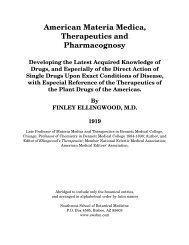SCARLET FEVER. Synonyms.—Scarlatina; Scarlet Rash. Definition ...
SCARLET FEVER. Synonyms.—Scarlatina; Scarlet Rash. Definition ...
SCARLET FEVER. Synonyms.—Scarlatina; Scarlet Rash. Definition ...
Create successful ePaper yourself
Turn your PDF publications into a flip-book with our unique Google optimized e-Paper software.
Predisposing causes are, poor hygienic surroundings, which in former<br />
times were the cause of so much erysipelas in hospitals, and following<br />
confinements. Age also predisposes to this lesion, those being the most<br />
susceptible who are between the ages of twenty and thirty. Previous<br />
attacks also render one more susceptible, thus being different from all<br />
other contagious diseases.<br />
Pathology.—Erysipelas is a true dermatitis, involving the skin,<br />
subcutaneous, and mucous surfaces. The blood-vessels are dilated and<br />
distended with blood, and cell-infiltration may extend into the deeper<br />
tissues, where suppuration is apt to take place. The cocci are found in<br />
the lymph spaces of the affected area, while beyond this they are found<br />
in the lymph vessels, where the battle is fought and won by the<br />
leukocytes (phagocytes).<br />
Aside from the local affection, the toxin in severe cases causes granular<br />
degeneration of the heart, kidneys, spleen, and liver. According to Osier,<br />
some of the worst cases of malignant endocarditis are secondary to<br />
erysipelas.<br />
Symptoms.—The period of incubation is variable, it being from three<br />
to ten days after the entrance of the infection before the development of<br />
the disease. The prodromal symptoms are common to inflammations<br />
generally; viz., headache, loss of appetite, furred tongue, partial arrest<br />
of the secretions. These terminate in the chill in the adult, or more likely<br />
in a convulsion, if the patient be a child. Following the chill, reaction<br />
occurs, with rapid rise in temperature, the thermometer registering-<br />
103° the first day, 104° the second, and 105° to 106° by the third or<br />
fourth day, usually the days of greatest intensity. The pulse is full and<br />
bounding, the tongue is coated with a dirty fur, or it is brown and dry.<br />
The skin is dry and more or less constricted, the urine is scanty and<br />
high colored, and the bowels are constipated.<br />
The local affection begins with a bright-red spot, slightly raised, more or<br />
less edematous, and with a tendency to spread rapidly. The part is hot,<br />
swollen, and painful, and often slight blisters form upon the affected<br />
part. If that part be the face, the favorite seat of the disease, the<br />
swelling extends to the eyes, which it soon closes; then involves the ears,<br />
which become enormously enlarged; and finally, when at its height, the<br />
features of the patient are so obliterated as to render him<br />
unrecognizable by his nearest friends.<br />
The Eclectic Practice of Medicine - PART I - Infectious Diseases - Page 169

















